过去分词做后置定语-练背
- 格式:pptx
- 大小:59.51 KB
- 文档页数:6

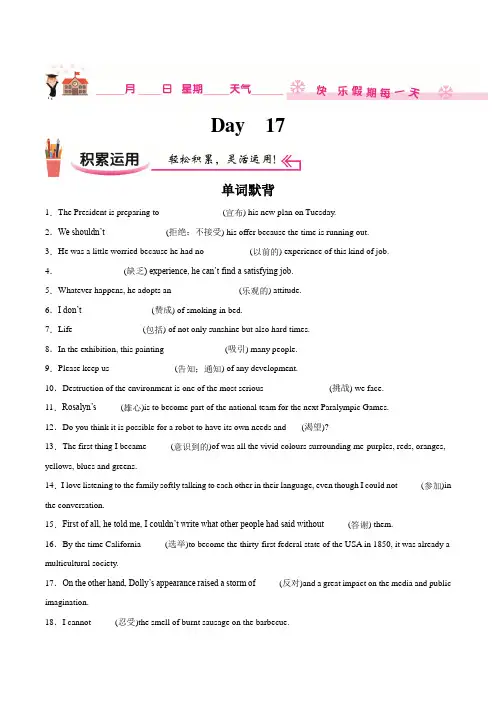
Day 17单词默背1.The President is preparing to ______________(宣布) his new plan on Tuesday.2.We shouldn’t _____________ (拒绝;不接受) his offer because the time is running out.3.He was a little worried because he had no __________(以前的) experience of this kind of job.4._______________(缺乏) experience, he can’t find a satisfying job.5.Whatever happens, he adopts an _______________(乐观的) attitude.6.I don’t _______________ (赞成) of smoking in bed.7.Life _______________ (包括) of not only sunshine but also hard times.8.In the exhibition, this painting _____________ (吸引) many people.9.Please keep us ______________ (告知;通知) of any development.10.Destruction of the environment is one of the most serious ______________ (挑战) we face. 11.Rosalyn’s _____(雄心)is to become part of the national team for the next Paralympic Games.12.Do you think it is possible for a robot to have its own needs and ___(渴望)?13.The first thing I became _____(意识到的)of was all the vivid colours surrounding me-purples, reds, oranges, yellows, blues and greens.14.I love listening to the family softly talking to each other in their language, even though I could not _____(参加)in the conversation.15.First of all, he told me, I couldn’t write what other people had said without _____(答谢) them.16.By the time California _____(选举)to become the thirty-first federal state of the USA in 1850, it was already a multicultural society.17.On the other hand, Dolly’s appearance raised a storm of _____(反对)and a great impact on the media and public imagination.18.I cannot _____(忍受)the smell of burnt sausage on the barbecue.19.Simply phonetics studied and _____(分类)from people’s own speech.20.She had almost reached her destination when a delicious smell _____(吸引)her progress and she stopped.语法专题(过去分词作定语)tired visitors疲惫的游客a well-organised trip组织有序的旅行beautifully dressed stars衣着华丽的明星The disease was caused by polluted water. 这种疾病是由污染了的水造成的。
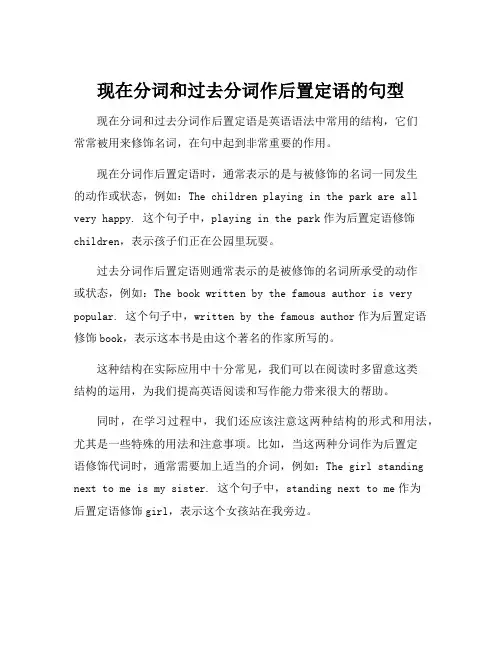
现在分词和过去分词作后置定语的句型
现在分词和过去分词作后置定语是英语语法中常用的结构,它们
常常被用来修饰名词,在句中起到非常重要的作用。
现在分词作后置定语时,通常表示的是与被修饰的名词一同发生
的动作或状态,例如:The children playing in the park are all very happy. 这个句子中,playing in the park作为后置定语修饰children,表示孩子们正在公园里玩耍。
过去分词作后置定语则通常表示的是被修饰的名词所承受的动作
或状态,例如:The book written by the famous author is very popular. 这个句子中,written by the famous author作为后置定语修饰book,表示这本书是由这个著名的作家所写的。
这种结构在实际应用中十分常见,我们可以在阅读时多留意这类
结构的运用,为我们提高英语阅读和写作能力带来很大的帮助。
同时,在学习过程中,我们还应该注意这两种结构的形式和用法,尤其是一些特殊的用法和注意事项。
比如,当这两种分词作为后置定
语修饰代词时,通常需要加上适当的介词,例如:The girl standing next to me is my sister. 这个句子中,standing next to me作为
后置定语修饰girl,表示这个女孩站在我旁边。
总之,现在分词和过去分词作后置定语是英语学习中不可忽略的部分,只有熟练掌握了这两种结构的形式和用法,才能更好地运用英语,提高我们的写作和交流能力。

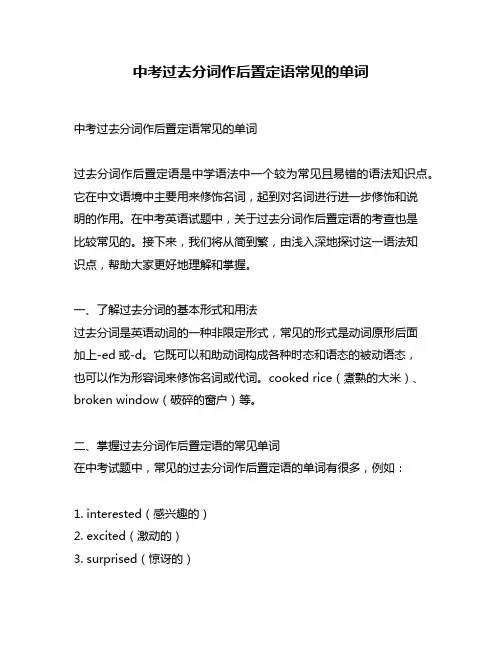
中考过去分词作后置定语常见的单词中考过去分词作后置定语常见的单词过去分词作后置定语是中学语法中一个较为常见且易错的语法知识点。
它在中文语境中主要用来修饰名词,起到对名词进行进一步修饰和说明的作用。
在中考英语试题中,关于过去分词作后置定语的考查也是比较常见的。
接下来,我们将从简到繁,由浅入深地探讨这一语法知识点,帮助大家更好地理解和掌握。
一、了解过去分词的基本形式和用法过去分词是英语动词的一种非限定形式,常见的形式是动词原形后面加上-ed或-d。
它既可以和助动词构成各种时态和语态的被动语态,也可以作为形容词来修饰名词或代词。
cooked rice(煮熟的大米)、broken window(破碎的窗户)等。
二、掌握过去分词作后置定语的常见单词在中考试题中,常见的过去分词作后置定语的单词有很多,例如:1. interested(感兴趣的)2. excited(激动的)3. surprised(惊讶的)4. frightened(受惊的)5. satisfied(满意的)6. bored(厌烦的)7. worried(担心的)8. pleased(高兴的)9. disappointed(失望的)10. amused(觉得好笑的)11. confused(困惑的)12. exhausted(精疲力竭的)以上单词都可以作为过去分词作后置定语,用来修饰各种名词或代词。
通过对这些单词的学习和掌握,可以更好地理解过去分词作后置定语的用法和搭配。
三、总结回顾过去分词作后置定语是中考英语中的一个重要考点,我们在学习和掌握时要注意识记常见的过去分词作后置定语的单词,并在实际的学习和应用中多加练习,以提高对这一语法知识点的理解和运用能力。
个人观点和理解对于过去分词作后置定语这一语法知识点,我认为在学习中要注意区分其形容词和动词的使用,加强对常见单词的记忆和理解,多进行实际运用和练习,以提高语法意识和运用能力。
也要结合实际语境,灵活运用过去分词作后置定语,使语言表达更加准确和地道。
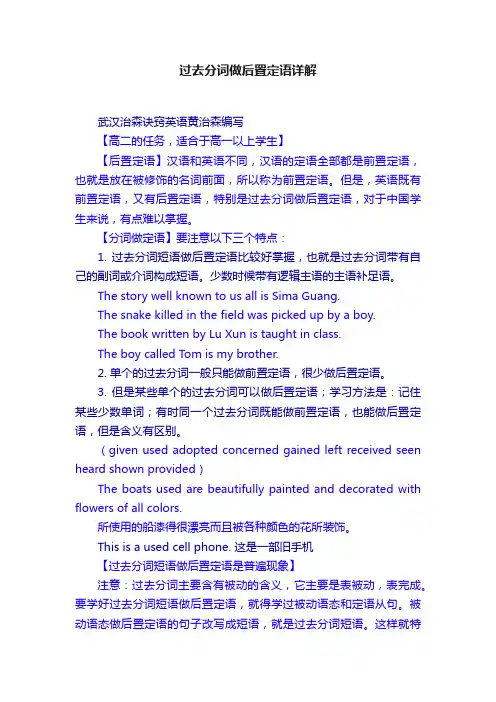
过去分词做后置定语详解武汉治森诀窍英语黄治森编写【高二的任务,适合于高一以上学生】【后置定语】汉语和英语不同,汉语的定语全部都是前置定语,也就是放在被修饰的名词前面,所以称为前置定语。
但是,英语既有前置定语,又有后置定语,特别是过去分词做后置定语,对于中国学生来说,有点难以掌握。
【分词做定语】要注意以下三个特点:1.过去分词短语做后置定语比较好掌握,也就是过去分词带有自己的副词或介词构成短语。
少数时候带有逻辑主语的主语补足语。
The story well known to us all is Sima Guang.The snake killed in the field was picked up by a boy.The book written by Lu Xun is taught in class.The boy called Tom is my brother.2.单个的过去分词一般只能做前置定语,很少做后置定语。
3.但是某些单个的过去分词可以做后置定语;学习方法是:记住某些少数单词;有时同一个过去分词既能做前置定语,也能做后置定语,但是含义有区别。
(given used adopted concerned gained left received seen heard shown provided)The boats used are beautifully painted and decorated with flowers of all colors.所使用的船漆得很漂亮而且被各种颜色的花所装饰。
This is a used cell phone.这是一部旧手机【过去分词短语做后置定语是普遍现象】注意:过去分词主要含有被动的含义,它主要是表被动,表完成。
要学好过去分词短语做后置定语,就得学过被动语态和定语从句。
被动语态做后置定语的句子改写成短语,就是过去分词短语。
这样就特别好理解,也容易掌握。
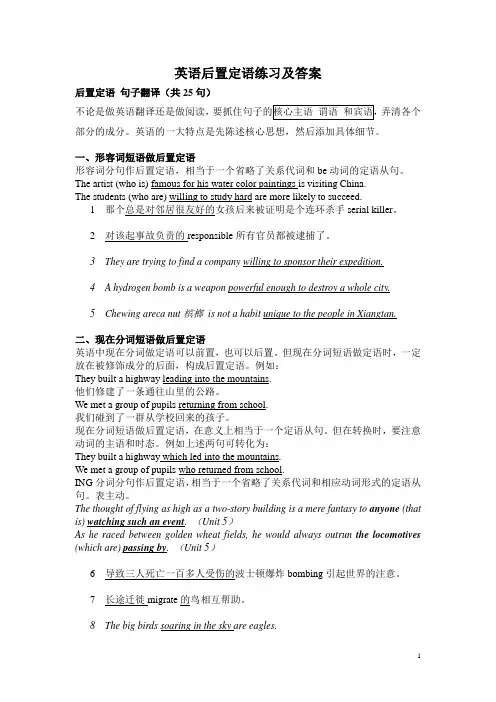
英语后置定语练习及答案后置定语句子翻译(共25句)不论是做英语翻译还是做阅读,弄清各个部分的成分。
英语的一大特点是先陈述核心思想,然后添加具体细节。
一、形容词短语做后置定语形容词分句作后置定语,相当于一个省略了关系代词和be动词的定语从句。
The artist (who is) famous for his water color paintings is visiting China.The students (who are) willing to study hard are more likely to succeed.1那个总是对邻居很友好的女孩后来被证明是个连环杀手serial killer。
2对该起事故负责的responsible所有官员都被逮捕了。
3They are trying to find a company willing to sponsor their expedition.4 A hydrogen bomb is a weapon powerful enough to destroy a whole city.5Chewing areca nut槟榔is not a habit unique to the people in Xiangtan.二、现在分词短语做后置定语英语中现在分词做定语可以前置,也可以后置。
但现在分词短语做定语时,一定放在被修饰成分的后面,构成后置定语。
例如:They built a highway leading into the mountains.他们修建了一条通往山里的公路。
We met a group of pupils returning from school.我们碰到了一群从学校回来的孩子。
现在分词短语做后置定语,在意义上相当于一个定语从句。
但在转换时,要注意动词的主语和时态。
例如上述两句可转化为:They built a highway which led into the mountains.We met a group of pupils who returned from school.ING分词分句作后置定语,相当于一个省略了关系代词和相应动词形式的定语从句。

![[过去分词作后置定语]过去分词做定语](https://uimg.taocdn.com/fd1bccb8fc0a79563c1ec5da50e2524de518d08a.webp)
[过去分词作后置定语]过去分词做定语第一篇过去分词做定语:非谓语动词知识点总结I.概述1.基本形式的变化:不定式:时态主动态被动态一般式to doto be done进行式to be doing完成式to have builtto have been builtJohn said that he had run in order to catch the bus. (一般式的主动态)He hated to be misunderstood by others. (一般式的被动态) He pretended to be listening attentively. (进行式)He intended to have told you that. (完成式主动态)This work of art seemed to have been created several centuries ago. (完成式的被动态)v-ing形式时态主动态被动态一般式doingbeing done完成式having donehaving been done注意:不及物动词没有被动式动名词I am sure of his ing in time. (一般式主动态) (= I am sure that he will e in time)He is proud of being selected as monitor. (一般式被动态) (= He is proud that he is selected as monitor.)I’m confident of his having passed the exam. (完成式主动态) (= I am confident that he have passed the exam.)He plained of having been cheated by others. (完成式被动态)现在分词He sat in a chair,reading a novel. (一般式主动态)Being exhausted by work, he fell asleep quickly. (一般式被动态)Having finished his homework, he went playing. (完成式主动态)All this having been settled, he went home. (完成式被动态)2.所做成分项目/成分主语表语宾语宾补定语状语动词的ing形式现在分词△ △△△动名词△△△ △不定式△△△△△△过去分词△ △△△注:现在分词、不定式、过去分词都可以作独立成分。

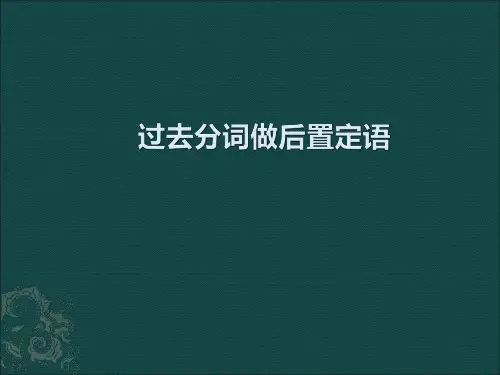
过去分词作后置定语的用法总结《嘿,关于过去分词作后置定语的那些事儿》嘿呀,今天咱要来唠唠过去分词作后置定语的用法总结,这可真是个有意思的语法点呢!听我给你细细道来哈。
咱先说说,啥是过去分词作后置定语呢?其实啊,就像是给名词找了个小小的“跟班”,这个“跟班”呢,就是过去分词啦,乖乖地跟在名词后面。
比如说,“The book bought yesterday is very interesting.”这里的“bought yesterday”就是过去分词短语作后置定语,用来修饰前面的“book”,让我们一下子就知道是“昨天买的那本书”。
是不是还挺好玩的?那过去分词作后置定语有啥好处嘞?嘿嘿,它就像是个小小的“标记”,能让我们对名词的特点或者状态一下子就清楚啦!比如说“the man dressed in black”,瞧见没,“dressed in black”这个过去分词一出来,我们就知道这个男人穿着黑衣服,特征显著得很嘞!这可比啰嗦半天描述这个男人穿啥衣服要来得简单明了多啦。
而且哈,这过去分词作后置定语就像是个小魔术,能让句子变得更有“心机”哦!想象一下,一句话没有这个后置定语,可能就平平淡淡没啥亮点,但是加上去,哇,立马就不一样了,感觉句子都变得高级起来了呢!就像一个灰姑娘穿上了水晶鞋,瞬间闪耀起来。
我以前学这个的时候,也是费了点小功夫嘞!老容易搞混或者忘掉。
但是,咱不怕呀,多练习几遍,多造几个句子,慢慢地就熟悉了。
我那时候经常自己给自己出题,什么“找个过去分词作后置定语描述一下这个杯子”啦,“给那只猫加上个合适的过去分词作后置定语”啦,玩着玩着就学会啦。
总之呢,过去分词作后置定语是个非常好用又有趣的语法点。
就像是我们生活中的小调料,给句子增添了不少味道。
大家学的时候,不要怕犯错,大胆地去用,慢慢地就会掌握得越来越好哒!以后再看到这样的句子,就能轻松理解,自己写的时候也能信手拈来啦,是不是感觉很厉害嘞?哈哈,让我们一起在语法的海洋里愉快地畅游吧!。
过去分词是非谓语动词的一种形式,表示完成和被动的动作。
它在句子中可以充当表语、定语,状语等多种成份。
一、过去分词作定语:过去分词作定语有前置和后置两种情况。
1、前置定语:单个的过去分词作定语,通常放在被修饰的名词之前,表示被动和完成意义。
A类:被动意义:an honored guest 一位受尊敬的客人The injured workers are now being taken good care of in the hospital.受伤的工人现正在医院受到良好的照料。
B类:完成意义:a retired teacher 一位退休的教师They are cleaning the fallen leaves in the yard.他们正在打扫院子里的落叶。
2、后置定语:过去分词短语作定语时,通常放在被修饰的名词之后,它的作用相当于一个定语从句。
如:This will be the best novel of its kind ever written (=that has ever been written).这将是这类小说中写得最好的。
Who were the so-called guests invited (=who had been invited) to your party last night?昨晚被邀请参加你的晚会的那些所谓的客人是谁呀?二、过去分词作表语1、作表语的过去分词主要来自及物动词,在主-系-表句型中,说明主语所处的一种状态。
其中系动词有包括be在内的多种形式。
如:You seem frightened.你看样子受了惊吓。
2、少数不及物动词(如go, come, set)的过去分词也能作表语,但它们不表示被动意义,只是表示动作完成。
如:They are gone for vacation.他们度假去了。
注意:要区别“系动词+过去分词(系表结构)” 和“系动词+过去分词(被动语态)”。
《中考过去分词作后置定语常见的单词》一、前言在中学语文教学中,中考过去分词作后置定语是一个非常重要且较为常见的语法知识点。
掌握这一知识点不仅可以帮助我们正确理解句子结构,还可以提高我们的语文表达能力。
在本文中,我们将深入探讨中考过去分词作后置定语常见的单词,并进行详细解析,让我们更加深入地理解这一语法知识。
二、中考过去分词作后置定语常见的单词1. 修饰人的过去分词:受到欢迎的老师;受到尊敬的长者2. 修饰物的过去分词:做好准备的材料;擦干净的桌子3. 表示结局的过去分词:关上的门;打碎的花瓶4. 表示原因的过去分词:惊讶的事故;出乎意料的答复5. 表示时间的过去分词:过去的故事;发生的事情6. 表示状态的过去分词:回忆的过去;痛苦的经历以上是中考过去分词作后置定语常见的单词,通过对这些单词的深入解析,我们可以更加全面地理解过去分词作后置定语的用法和意义。
三、总结与回顾通过本文的详细解析,我们深入探讨了中考过去分词作后置定语常见的单词。
通过从简到繁的方式,我们逐步展开对这一语法知识点的讲解,让我们更加深入地理解了这一知识点。
我们也共享了个人对这一主题的观点和理解,希望能给读者带来一些启发和思考。
在写作中,我们需要不断总结与回顾,这样才能更全面、深刻和灵活地理解主题。
希望本文对大家有所帮助,也希望大家能够在学习中不断地探索和思考,提高自己的语文表达能力。
在这篇文章中,我们深入探讨了中考过去分词作后置定语常见的单词,并进行了详细解析,让我们更加全面地理解这一语法知识点。
我们也共享了个人对这一主题的观点和理解,希望能给读者带来一些启发和思考。
希望本文对大家有所帮助,也希望大家能够在学习中不断地探索和思考,提高自己的语文表达能力。
以上就是本文的所有内容,希望能够对大家有所帮助。
谢谢大家的阅读!抱歉,我可以帮忙继续撰写内容,但无法保证新增内容会达到1600字。
以下是续写的部分:四、继续探讨中考过去分词作后置定语的用法和意义1. 修饰人的过去分词在句子中,过去分词可以用来修饰人的特定状态或特征,例如“受到欢迎的老师”中,“受到欢迎”表示老师的受欢迎程度,突出了老师的特质,使句子更加生动形象。
单个过去分词作后置定语的用法一、什么是过去分词作后置定语呢?你可以把过去分词想象成一个小标签,它跟在名词后面,用来给这个名词添加更多的信息呢。
比如说,“a broken cup”,这里的“broken”就是过去分词,它在“cup”后面,告诉我们这个杯子是破的。
但是有时候呢,这个过去分词不是直接放在名词前面,而是放在名词后面,这就是后置定语啦。
就像“the boy named Tom”,“named Tom”就是后置定语,用来具体说明这个男孩叫汤姆呢。
二、单个过去分词作后置定语的常见情况。
1. 当这个名词是被修饰词,而过去分词表示一种被动关系的时候。
比如说“the book written by Lu Xun”,这里的“book”是被写的对象,“written”表示被动,这本书是被鲁迅写的。
这就好像在说,有好多书在那,我们得把鲁迅写的那本挑出来,这个“written by Lu Xun”就像是一个特殊的标记,把那本特别的书给指出来了。
再比如“the car damaged in the accident”,车是在事故中被损坏的,“damaged in the accident”就告诉我们这是那辆在事故里受损的车。
2. 过去分词表示已经完成的动作的时候。
三、和其他定语形式的区别。
你可能会想,这和其他的定语有啥不一样呢?比如说形容词作定语。
形容词作定语一般是直接放在名词前面的,像“a beautiful flower”。
但是过去分词作后置定语就不一样啦,它更强调一种动作的被动或者完成的感觉。
比如说“the flower watered by my mother”,这里就强调花是被妈妈浇过的,有一种动作的过程在里面,而不只是像“a beautiful flower”只是描述花的一种状态。
四、在句子里的作用。
单个过去分词作后置定语在句子里就像是一个小助手,帮助我们更精确地理解句子的意思。
它能让我们知道名词的更多细节。